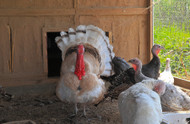Fascinating Facts About Turkeys
Posted by The Turkey Team on 27th Feb 2022
Whilst many of us love roast traditional turkeys during the festive season and turkey has become increasingly popular as a healthy alternative to chicken and red meat, these are far from the only facts out there that makes them truly fascinating creatures to think about.
The Turkey Social Network
Turkeys are exceptionally social creatures who have been compared to dogs in the way that they establish strong social bonds, flocks and family units with each other. In some cases, they will travel in groups of up to 200.
This may be the reason why they have not only their distinctive gobble but up to 20 different vocalisations (Compared to the roughly 100 different phonemes in the International Phonetic Alphabet for humans), some of which can be heard up to a mile away.
Turkeys also have individually recognisable voices which highlight how social they are as creatures in the wild.
This communication is key as well; most turkeys tend to live in an area around 1,000 acres in size and can learn the precise details of their habitat with impressive levels of recall.
The Colour Changing Throat
One of the most unique and eye-catching parts of a turkey is the piece of skin over the throat known as a wattle, which is also one of the most important parts of a turkey.
It is a mood indicator, changing colour depending on how the turkey is feeling.
When it turns blue, it means that the turkey is happy or excited, but when it is angry and about to attack it turns a very bright shade of red.
Turkeys Can Fly Very Fast
Turkeys are not typically considered to be flying birds owing to their odd size and shape, and indeed many domesticated turkeys struggle to fly due to their size.
Wild turkeys, however, are another matter entirely. They can run on land at around 25mph but their flying speed is closer to 55mph, which is incredibly fast for their size.
Of course, they cannot keep that speed up for very long, need to land on the floor to eat and have issues with manoeuvring, but given how we do not associate them with flying, they are pretty capable.
They even roost in trees at night like other birds to stay away from predators.
They Nearly Went Extinct
In the modern world, turkeys are plentiful, with an estimated population of around seven million. However, at one point there was a genuine fear that these most unique of birds would be hunted to extinction, reaching a population low of 30,000 at one point.
When the first colonists arrived in America, there were ten million turkeys and it was believed by settlers that they would never run out, so there were no regulations or restoration controls.
This in combination with land being claimed across the country meant that turkeys declined at a staggering rate.
Interestingly, what saved the bird was the Wall Street Crash of 1929, which meant that many smaller farmers gave up the life and moved to the city, as depicted a decade later in the John Steinbeck novel The Grapes of Wrath.
Without over-farming, turkeys gradually returned to their native habitats and it would take a concerted effort and the invention of the net cannon to help with the sensational recovery of turkey populations in the wild.



